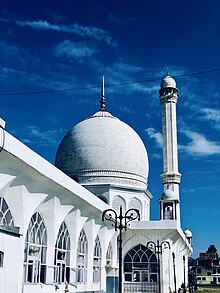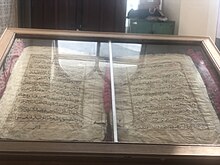| Hazratbal Shrine | |
|---|---|
| درگاہ حَضْرَت بل | |
 Dargah Hazratbal, Srinagar Dargah Hazratbal, Srinagar | |
| Religion | |
| Affiliation | Islam |
| District | Srinagar District |
| Region | Kashmir Valley |
| Leadership | Jammu and Kashmir Muslim Waqf Board |
| Status | Active |
| Location | |
| Location | Hazratbal |
| Municipality | Srinagar |
| State | Jammu and Kashmir |
| Country | India |
  | |
| Territory | Jammu and Kashmir |
| Geographic coordinates | 34°7′45″N 74°50′32″E / 34.12917°N 74.84222°E / 34.12917; 74.84222 |
| Architecture | |
| Type | Islamic architecture |
| Style | Classical |
| Specifications | |
| Length | 105 metres (344 ft) |
| Width | 25 metres (82 ft) |
| Dome(s) | 1 |
| Minaret(s) | 1 |
The Hazratbal Shrine (Kashmiri: درگاه حَضْرَت بل), popularly called Dargah Sharif ("the Holy Shrine"), is a Muslim shrine located in Hazratbal locality of Srinagar in Jammu and Kashmir, India. It contains a relic, Moi-e-Muqqadas, believed to be the hair of the Islamic prophet Muhammad. It is situated on the northern bank of the Dal Lake in Srinagar, and is considered to be Kashmir's holiest Muslim shrine.
The name of the shrine is a combination of the Arabic word hazrat (lit. 'respected') and the Kashmiri word bal (lit. 'place').
History and present status


Hazratbal Shrine was initially established by Inayat Begum, the daughter of Khwaja Nur-ud-Din Eshai and the custodian of the relic. The first building of the shrine was constructed in 17th century by Mughal subedar Sadiq Khan during the emperor Shah Jahan's reign. This was initially called Ishrat Jahan. The building was ordered to be converted into a prayer hall in 1634 by Shah Jahan. Construction of the present day structure was started in 1968 and took 11 years to complete, finishing in 1979.
The relic was first brought to Kashmir by Syed Abdullah Madani, a purported descendant of Muhammad who left Medina (in present-day Saudi Arabia) and settled in the South Indian city of Bijapur in 1635, at a time when the Islamic Mughal Empire was rapidly expanding across India.
Following Abdullah's death, his son Syed Hameed inherited the relic. The region was conquered by the Mughals shortly afterwards, and Hameed was stripped of his family estates. Finding himself unable to care for the relic, he passed it to Khwaja Nur-ud-Din Eshai, a wealthy Kashmiri businessman.

When the Mughal emperor Aurangzeb was informed of its existence and transfer, he had it seized and sent to the shrine of Sufi mystic Mu'in al-Din Chishti in Ajmer, and imprisoned Eshai in Delhi. After nine days Aurangzeb had a dream of Muhammad with four caliphs: Abu Bakr, Umar, Usman and Ali. In the dream, Muhammad ordered him to send the Moi-e-Muqaddas to Kashmir from Ajmer. Then Aurangzeb returned it to Eshai and allow him to take it to Kashmir. However, Eshai had already died while imprisoned. By 1700, the relic had been transported to Kashmir, along with the body of Eshai. There, Inayat Begum, the daughter of Eshai, became the custodian of the relic and established the Hazratbal Shrine. Since then, her male descendants have been caretakers of the relic at the mosque. Begum's male descendants belong to what is known as the Banday family. As of 2019, three main members care for the relic: Manzoor Ahmad Banday, Ishaq Banday and Mohiuddin Banday. The relic is displayed for public view only on special Islamic occasions, such as the birthdays of Muhammad and his four main companions.

 The head cleric of the shrine displaying it to the general public on different occasions
The head cleric of the shrine displaying it to the general public on different occasions
1963 relic disappearance episode
See also: 1963 Hazratbal Shrine theftThe Moi-e-Muqqadas was reported to have gone missing from the shrine on 27 December 1963. Following its disappearance, mass demonstrations were held all over the state, with hundreds of thousands of protesters out in the streets. On 31 December, Indian Prime Minister Jawaharlal Nehru made a broadcast to the nation on the disappearance of the relic, and sent a team from the Central Bureau of Investigation into Jammu and Kashmir to probe the suspected theft. It was recovered by Indian authorities on 4 January 1964, at the instigation of Sayyid Meerak Shah Kashani and others. Shah Kashani said he had seen the relic many times and could easily identify it. Identification by its caretakers and other investigation made by the Government of Jammu and Kashmir (law and order), special identification team says its authenticity is indeed original.
A public viewing of the relic was held on 6 February 1964 in remembrance of Ali bin Abu Talib.
The incident led to communal tensions and riots in the Indian state of West Bengal and East Pakistan (now Bangladesh), due to which India saw a refugee influx of around 200,000 people between December 1963 and February 1964.
Demands were made that it be officially identified by the elders. It was charged that political bosses had stolen the hair so they could later come to power by taking credit for restoring it.
See also
- Eidgah Shah-i-Hamdan
- Ajmer Sharif Dargah
- Ziyarat Naqshband Sahab
- Hamza Makhdoom
- Khanqah-e-Moula
- Dastgeer Sahib
References
- "Moslems Riot Over Theft of Sacred Relic", Chicago Tribune, 29 December 1963, p1
- "Kashmir Indians Yield at Shrine". The New York Times. Reuters. 7 August 1994. ISSN 0362-4331. Retrieved 10 October 2021.
- ^ ""The Majestic Hazratba Shrine"". Kashmir Newsline | Leading News Portal from Kashmir| Authentic, Credible, Accurate News from Kashmir. 14 October 2021. Retrieved 17 June 2022.
- "Hazratbal, the shrine and the holy relic". The Dispatch. 10 January 2018.
- Kapur, Saurabh. "Hazratbal Shrine". The Times of India. Retrieved 17 June 2022.
- "Hazratbal". Department of Tourism Govt of Jammu & Kashmir. Archived from the original on 18 August 2021. Retrieved 10 October 2021.
- Warikoo, Kulbhushan (2009). Cultural heritage of Jammu and Kashmir. Pentagon Press. p. 173. ISBN 978-81-8274-376-2.
- Akbar, M. J. (8 February 2018). Kashmir: Behind the Vale. Roli Books Private Limited. pp. content-17. ISBN 978-81-936009-6-2.
- Warikoo, Kulbhushan (2009). Cultural heritage of Jammu and Kashmir. Pentagon Press. pp. 173–174. ISBN 978-81-8274-376-2.
- ^ Hari Narain Verma; Amrit Verma (1998). Decisive battles of India through the ages, Volume II. GIP Books. p. 124. ISBN 978-1-881155-04-1. Retrieved 22 June 2010.
- "Head priest Hazratbal shrine Ghulam Hassan Banday passes away". Greater Kashmir. 24 June 2019. Retrieved 10 October 2021.
- ^ Ahmad, Khalid Bashir (27 December 2018). "Kashmir: The Sacrilege And The Turmoil". countercurrents.org. Countercurrents. Retrieved 19 January 2023.
- Francesca, Neelam; Srivastava, Rashmi (2008). Secularism in the postcolonial Indian novel: national and cosmopolitan narratives in English. Volume 17 of Routledge research in postcolonial literatures. Routledge. p. 70. ISBN 978-0-415-40295-8. Retrieved 22 June 2010.
- "Hazratbal shrine with holy relic has a tumultuous history".
- "Hanging By The Relic". Kashmir Life. 7 July 2014. Retrieved 23 January 2017.
- Das, Mayurakshi (January 2018). "Title: Calcutta Cauldron: City-life during the January 1964 Riots". Indian History Congress Proceedings.
- Mehta, Ved (31 May 1968). "IV- The Holy Hair of the Muslims". The New Yorker. Retrieved 1 November 2021.

